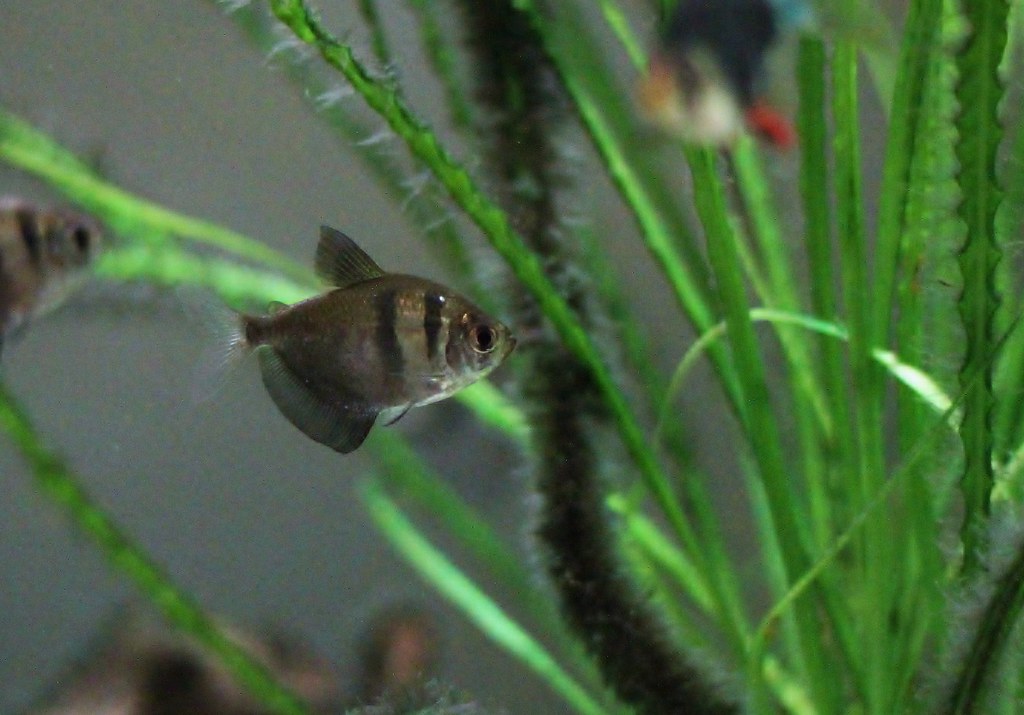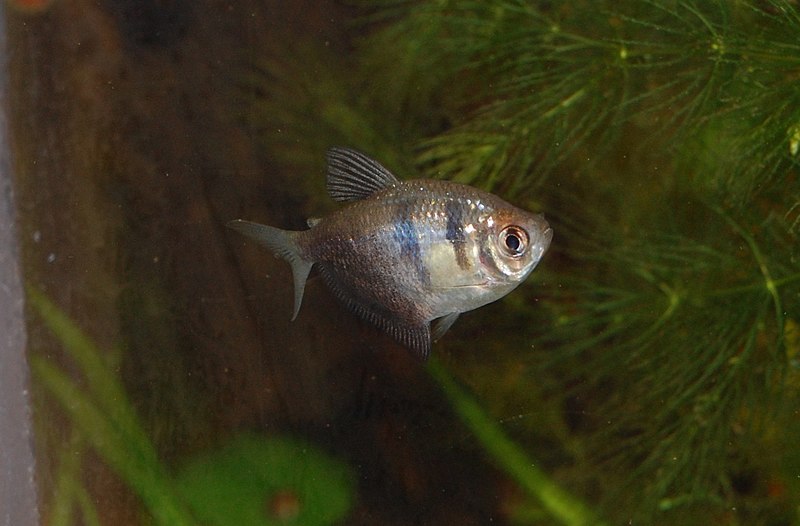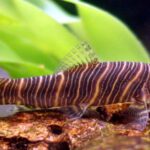The black skirt tetra or black widow tetra is among the most popular schooling fish.
This tetra species is fast-moving and is a great choice for beginner aquarists.
Multiple reasons make the freshwater black skirt tetra easy to maintain.
However, we’ve created an ultimate guide that will make everything crystal clear about black skirt tetra care. It includes habitat requirements, water parameters, tank mates, breeding, and more!
Species Overview
Although most of these fish have a dark and bold color, black stripe tetra comes in a variety of colors. This species has a distinctive look that makes it stand out from other fishes in an aquarium. It is from the Characidae fish, a family known for its vivid colors.
Black skirt tetras are freshwater fish and are present abundantly in regions like Argentina, Paraguay River, Brazil, and so on.
| Category | Rating |
| Life Span | 3-5 Years |
| Family | Characidae |
| Color Variety | White, Silver, Black |
| Care Level | Moderate |
| Compatibility | Peaceful with Many Types Of Fish |
| Food and Diet | Omnivore |
| Temperament | Mildly Aggressive |
| Tank Size (Min.) | 15 Gallons |
| Tank Setup | Rocks and Plants in Freshwater |
| Size | 1-2.5 inches |
The black skirt tetra has become quite a popular species for the aquarium trade. Many beginner aquarists choose this fish due to its lifespan and other maintenance aspects that aren’t a burden at all. From finding the right black skirt tetra water tank to food and diet, everything is easy.
You will find this species in nearly any aquarium and pet store around you.
These fish are habitual of staying in captivity and grow better in such conditions rather than open water. However, petting a black striped tetra is easy as long as you can take care of its health.
Lifespan
The average lifespan for a healthy black skirt tetra is nearly 3 to 5 years, and that too in captivity. Of course, there are instances in which these fishes lived beyond the average age. However, these cases are extremely rare.
The main factors that affect the lifespan of this fish species are lackluster tank settings, bad water conditions (pH, contaminants, etc.), and more.
So, if you are willing to pet a black striped tetra, ensure that the water tank conditions are suitable for its health.
Appearance
The shape of black striped tetras is mainly iconic tetragonal similar to other species of the Characidae family.
The bottom end of the fish tapers towards the tail, while the front of the body is taller. The long-fin tetras appear unique in shape when they mature.
Besides, the black stripe tetra has different fin shapes. For example, you may see the tailfin, which is forked-shape and is relatively thin, whereas the dorsal fin has a square shape and is small. Furthermore, you will find an anal fin at the bottom of its body as well.

The anal fin extends towards the tail from the middle of the body. Also, this fin has a sharp shape since it is thick near the belly while tapering towards the end. The fins are easily noticeable as they are either black or grey.
Further, the fins have tiny rays that you can see upon close inspection and are translucent. This fish’s head is more reflective than any other part of the body. You should know that the primary color of the black striped tetra is greyish silver.
This silver-grey will start from the middle of the body, and towards the end, it fades to a darker and blacker shade.
The two stripes run vertically on the front of the body and compliment the color gradient vividly. For your information, determining the sex of this fish isn’t easy.
The black skirt tetra gender identification is a difficult task. You will notice that there are subtle differences between male and female black striped tetras.
However, during breeding, female black striped tetra appears plumper and is relatively larger than male black skirt tetra.
The anal fin is wider on the male black skirt tetra fish than on females.
Size
Are you wondering about the size of the male and female black skirt tetra? How big do black skirt tetras get?
Well, the answer varies, depending on the habitat conditions since they can only grow a maximum of 2.5 inches in size. At full maturity, a healthy black skirted tetra can be as big as 3 inches.
Regardless, poor water tank conditions can limit their growth and keep them under 2-2.5 inches.
Black Skirt Tetra Care
Caring for your male or female black skirt tetra isn’t a problem at all. Even if you don’t have enough experience petting fish or keeping aquariums, black skirted tetras are less demanding and thrive solely on adequate care and monitoring.
Therefore, keep the water tank conditions at best during all times to keep skirt tetra healthy. The species appear much healthier and fast-moving once the water in the tank is fresh and clean.
Tank Size
On average, Black skirt tetra’s tank size is around a minimum of 15 gallons or more. This volume is enough to let a small fish group swim easily. Nonetheless, you can choose a 20-gallon capacity for your water tank to keep your fish in the best condition.
Larger tanks are also better when you wish to keep multiple fish species or a large group in your aquarium. Moreover, fish experts suggest that you choose a wider and high-capacity tank to prevent overcrowding.
Water Parameters
One of the main things without which your black skirted tetras cannot survive is healthy water conditions.
A spacious tank won’t suffice unless there is clean and contaminant-free water present in the tank. Furthermore, poor water parameters pose significant risks to black skirt tetras’ health.

You can inquire about the origins of the black skirt tetra fish that you are keeping. By learning their natural habitat, you can replicate the water parameters such as acidic and warmer if the fish is from South America.
View the expert guidelines on maintaining healthy water tank conditions for your black skirt tetras.
- 6.0-7.5 pH levels
- 4-8 dKH water hardness
- 70°-85°F as water temperature
Furthermore, make sure that you invest your money in a reliable water testing kit to keep accurate readings of the water tank.
Although the black skirt tetra fish species is tougher than other species of the same family, they are vulnerable to sudden water parameters shifts.
What to Put In Their Tank?
Do you want to decorate your black skirt tetra’s water tank? It is a creative mode of caring for your fish and improving your skills for fishkeeping. There are various methods and options that you can choose to decorate the water tank for your black skirted tetra species.
You can replicate the original ecosystem of the black skirt tetra fish. For instance, filling the water tank with real-like sea wildlife decorations will enhance the appearance and let you experiment with your fish.
Whether male or female, black skirt tetra fish love plants and swimming through them.
You can place hard-chew plants since they are the most common feeding option for black widow fish in their natural habitat.
You should have taller plants or other decorations at the tank’s corners since the black skirt tetras remain near the middle. It will create the perfect hiding and venturing ground for your fish.

Keep in mind that the black striped tetras are active and free swimmers, which means that you shouldn’t plant trees that are too dense. In fact, try not to go overboard with the plant decorations.
So, you may hide the corners and perimeter of the tank with a few tall plants. For the center of your black stripe tetra fish’s tank, river gravel, or sandy substrate (dark) will work perfectly.
While the dark substrate won’t encourage black skirt tetra to go down in the tank, it will replicate the look of dead leaves.
Create hiding spots using driftwood or cave systems. Fish can feel shy or threatened at any instance, and providing venture points can help. Use a powerful water filter system to eliminate and remove all contaminants such as nitrate and ammonia.
For improving water quality manually and providing optimal water parameters for your black skirt tetra fish, you can try changing water every week.
Common Diseases
Every fish is prone to some diseases, and the same is the case with the black skirt tetra freshwater fish.
The most frequent causes of health problems and diseases in black stripe tetras are fungal and bacterial infections. However, water purification can help with fish fungus and other problems.
Moreover, if water filtration doesn’t seem to improve the quality of the water tank, you can try replacing the water now and then, along with providing the right medication. On the other hand, there is a rare yet severe health problem for black skirt tetras known as Ich.
It causes a variety of problems, including white lesions on the fish body. It is a stress-induced parasitic infection that normally attacks freshwater fish, particularly black striped tetras in this case. Cleaning your water tank can keep your fish calm and safe from Ich.
While this condition isn’t difficult to treat, it is contagious and can spread quickly. In fact, when your black tetra fish has Ich, separate it from others safely. Once you clean your water tank and maintain optimal water parameters, the chances of Ich will be significantly low.
What Do Black Skirt Tetra Eat?
Feeding your fish is important since improper diet can impact their health and immunity, which makes them susceptible to diseases.
When it comes to black skirt tetra, they normally feed on any insects or plants they come across in the wild. Hence, they aren’t picky about their food.
Pellets, nutritious flakes, or even commercially available dry food can serve as the best diet option for your black skirt tetras.
Brine shrimps and bloodworms are nutritious for black skirt tetra. Several fishkeepers and hobbyists feed live food along with dried, frozen food to their black skirt tetras.
These fishes also eat algae but in small amounts and occasionally. According to the nature of the fish under captivity, it will eat anything that you provide in the water tank.
Behaviour & Temperament
If you think that the behavior and temperament of black skirt tetra fish are intolerable, you are wrong. As discussed earlier, this fish species is the easiest to keep and maintain. Although the black skirt tetra is mildly aggressive, you won’t find any noticeable signs of aggression.
They are peaceful and calm in water tank captivity and optimal water parameters. However, their aggression towards fish with long fins is something that you should consider beforehand.
Sometimes, black skirted tetra can nip the fins of angelfish or betta fish.
Apart from that, black skirt tetras quite calmly and peacefully get along with other types of fish. Besides, schooling your black skirt tetras isn’t a difficult task. The fish mostly spends its time swimming and remains curious about its surrounding.
Furthermore, skirt tetras in an aquarium stay together during the day, but one or two usually do something other than what the group is doing.
Black Skirt Tetra Tank Mates
It is better to keep a black skirt tetras group because of their shoaling nature. To keep the fish engaged and lively, add a group of no less than 5 black skirt tetras. In fact, fishkeepers suggest that you should get more than 5 fish if your water tank supports the capacity.
The surroundings appear more comfortable to every black skirt tetra when more fish are swimming around. However, if you think of adding different species with your black skirt tetra, you can view the short list below:
- Dwarf Gourami
- Neon Tetra
- Cardinal Tetra
- Harlequin Rasbora
- Cory Catfish
- Celestial Pearl Danio
- Bolivian Rams
- Chili Rasbora
- Honey Gourami
The above is the list of the most compatible fish species which can live in peace and comfort with the black skirt tetra.
Ensure that you don’t include any aggressive fish species in the tank with your black skirt tetra because their passive nature makes them susceptible to harm and attack.
Mainly, avoid long-finned fish because black skirt tetra chases them and nip the fins without an apparent cause.
Breeding
Breeding this fish species is relatively more time-consuming and requires effort. The main work that you have to do is to first identify the male black skirt tetra from the female black skirt tetra.
One more thing to know is that these fish rarely care about their eggs or black skirt baby fish.
Pre-Breeding
You have to breed them in an individual tank to keep the babies safe from other adult fishes as they usually eat the eggs and even the baby fish (fry). For breeding, set up a 10-gallon tank breeding tank and replicate the water parameters as the original bigger water tank.
Also, you can use a net, artificial grass, or a spawning mop as well. These accessories will hide the fish eggs and make it difficult for adult fish to find them. Once the breeding setup is ready, you can take out the bonded pair and place them in the breeding tank.
If the male black skirt tetra causes harm or is aggressive, separating it for a while is the best strategy. Otherwise, monitor the two fishes as they breed. Feeding protein-rich food will help the female swell with eggs.
Mid-Breeding
If the breeding is successful, the female black skirt tetra can lay over 1,000 eggs inside the breeding tank. This fish species don’t choose a single spot for laying eggs but rather spreads them across the entire tank unevenly.
That is why you may notice the eggs at the bottom of the tank. Thus, having a net or spawning mop can help save the eggs from entering the gravel or getting lost inside the substrate by catching them before they sink. The mesh netting can keep the eggs safe from adult fishes as they keep breeding.
Hatching
The eggs usually hatch in a timeframe of 24-36 hours. However, take the adult fish out of the breeding tank and place them back in the main tank, after the breeding. The initial diet of the baby fish is the egg sac after which you can start providing fry food (several days later).
It takes only a couple of weeks before the baby fry grows and starts consuming baby brine shrimp. Note that you have to keep the baby fish fry separate from adult fishes until they are adult and mature.
Final Thoughts
So, we hope the guide offered all the relevant information that you needed to begin your fishkeeping activities with black skirt tetra.
Well, you can easily acquire this fish species from any pet store or commercial aquarium. They are slightly difficult to breed as the process requires some work.
Nevertheless, black striped tetra isn’t picky when it comes to food and will eat just about anything that you provide in the main tank.
Keeping the fish healthy isn’t a problem as well since all you have to do is keep the tank safe and water parameters at optimal. Try to include only the fish that you think are peaceful and won’t be aggressive or nip your black skirt tetras.


